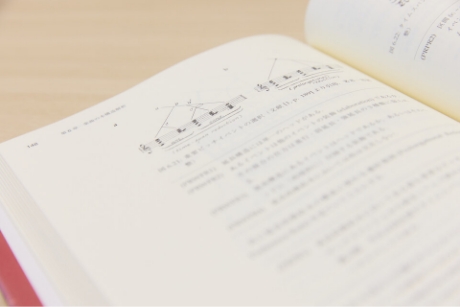
Are music and language related by the same rules?


#Asia University research
TOJO Satoshi Professor
Faculty of Business Administration Department of Data Science
2023.09.01
In this series, "If it's not interesting, it's not academia!" we will introduce research content and anecdotes of faculty members at Asia University. The first feature is Professor TOJO Satoshi Department of Data Science Faculty of Business Administration.

Communication
The Beginning
A simple "sound"
The Beginning
A simple "sound"
For example, vervet monkeys make different vocalizations depending on whether the enemy is an eagle or a snake. Depending on the difference in the cry, the companions who hear it will change the way they protect themselves. Jushimamatsu has three phonemes, and sings by combining these phonemes. What's interesting is that there are rules about the order of phonemes, and only chirping that follows a certain grammar has a message as a sentence. Males who can sing for a long time are handsome. For sentences to have length, in-sentence repetitions appear. Does this mean something? But no. To them, only "long" is important, repetition has no meaning, and neither the tweeter nor the listener remembers the number of times.
What about us humans? From the time when we used drums, flutes, and vocalizations to convey our intentions, humans gradually came to put meanings or messages into the combination of sounds. It is nourished by brain development and civilization.
In the Pidahan language spoken by the ethnic minority in Brazil, even now, almost one word is one sentence. It is said that it can be conveyed through humming and whistling. If you have enough, that's fine. However, in a society where the population has increased and complex communication is required, this is not the case. Combining sounds or just one simple word wasn't enough to convey one's intentions.
Hope and resolution
Repeating common structures
What is it?
Repeating common structures
What is it?

This is where the special abilities unique to humans come into play. It's a stack feature.
As we speak and listen to words, we store them in the hippocampus for a short period of time.
For example, if you hear someone say “Shibuya”, you will stack that word and expect the next word, “Are you going, have you been there, or is there new store information?” Next, when I was asked to go to the movies, I thought, "Should I go or did I go?" Memorize, pile up unsolvable homework, know in the last word. It's a momentary thing, but for each word, I always have the expectation of "I wonder if it will be like this" and the homework to answer the question.
The structure is the same for languages other than Japanese. What did Ann do with the short sentence “Ann reads a book”? →I read it. Then what? → If it comes with a, it's a single thing. →When I hear "book", I'm convinced. Such structures within a single phrase can be broken down into combinations of nouns, noun phrases, verb phrases, articles, transitive verbs, etc., and they always proceed in a certain direction toward memorization, questioning, and resolution. This is called context-free grammar, and most of the words we see and hear have this structure.
And the music we listen to also has a similar structure to it.
If you continue with Doremi, will Fa come next? Or, in children's songs and folk songs, you can imagine that the next melody will naturally be like this. There is a chord rule called cadence in musical terms. The tonic (T) that is the theme, the dominant (D), and the subdominant (S) that adorn the D form a sort of basic form, and everyone feels that when the T comes at the end, it is the end. has become There is a stack of sounds heard, expectations and doubts, and a solution. Music has a grammatical structure similar to language.
This is proof that music and language for humans have the same roots.
As we speak and listen to words, we store them in the hippocampus for a short period of time.
For example, if you hear someone say “Shibuya”, you will stack that word and expect the next word, “Are you going, have you been there, or is there new store information?” Next, when I was asked to go to the movies, I thought, "Should I go or did I go?" Memorize, pile up unsolvable homework, know in the last word. It's a momentary thing, but for each word, I always have the expectation of "I wonder if it will be like this" and the homework to answer the question.
The structure is the same for languages other than Japanese. What did Ann do with the short sentence “Ann reads a book”? →I read it. Then what? → If it comes with a, it's a single thing. →When I hear "book", I'm convinced. Such structures within a single phrase can be broken down into combinations of nouns, noun phrases, verb phrases, articles, transitive verbs, etc., and they always proceed in a certain direction toward memorization, questioning, and resolution. This is called context-free grammar, and most of the words we see and hear have this structure.
And the music we listen to also has a similar structure to it.
If you continue with Doremi, will Fa come next? Or, in children's songs and folk songs, you can imagine that the next melody will naturally be like this. There is a chord rule called cadence in musical terms. The tonic (T) that is the theme, the dominant (D), and the subdominant (S) that adorn the D form a sort of basic form, and everyone feels that when the T comes at the end, it is the end. has become There is a stack of sounds heard, expectations and doubts, and a solution. Music has a grammatical structure similar to language.
This is proof that music and language for humans have the same roots.
Disappointed
Fun too
Common?
Fun too
Common?

Of course, languages have developed differently depending on the region. It was school education in the early modern period that fixed "national languages" for each country and region. However, there is a strong affinity between the music of each region and the language. Canzone is Italian, with its emphasis on long and short notes, chanson is French, with its many ups and downs in tone, and German lied, with its strong accents. Such musical images are already inherent in each language.
In children's songs, folk songs, and enka, the flow from expectation to resolution is extremely simple. So we expect and imagine the next melody, and are satisfied that it is as expected. The process to resolution is simple. So, in some cases, it feels like a rut. I want a twist.
If it follows the grammar of the cadence, it is easy to listen to and feels good. Adding a few notes that go against that is a gamble on whether it will create a sense of anxiety or arouse expectations of something interesting. In Japan, Ryuichi Sakamoto, Yumi Matsutoya, and more recently Kenshi Yonezu have incorporated harmonic progressions that deviate slightly from the textbook in their music. I think this is a case where betraying expectations in musical grammar has led to something good.
Perhaps the same can be said about words.
When we encounter a word that is different from what we expected or anticipated, it can have an emotional impact. This can sometimes happen in haiku, tanka, poetry, novels, manzai, comedy sketches, and so on.
There is a concept called convergent evolution. It means that species that diverged a long time ago in the evolutionary process have similar forms in similar environments. Music and language are also thought to have undergone a form of convergent evolution.
At first, humans probably communicated with only single sounds. Eventually, they used short melodies, drums, flutes, and other sounds as a means of communication. When words were born, music and language separated, but the two, which share the same root, probably acquired a similar structure and have continued to exist to this day.
In children's songs, folk songs, and enka, the flow from expectation to resolution is extremely simple. So we expect and imagine the next melody, and are satisfied that it is as expected. The process to resolution is simple. So, in some cases, it feels like a rut. I want a twist.
If it follows the grammar of the cadence, it is easy to listen to and feels good. Adding a few notes that go against that is a gamble on whether it will create a sense of anxiety or arouse expectations of something interesting. In Japan, Ryuichi Sakamoto, Yumi Matsutoya, and more recently Kenshi Yonezu have incorporated harmonic progressions that deviate slightly from the textbook in their music. I think this is a case where betraying expectations in musical grammar has led to something good.
Perhaps the same can be said about words.
When we encounter a word that is different from what we expected or anticipated, it can have an emotional impact. This can sometimes happen in haiku, tanka, poetry, novels, manzai, comedy sketches, and so on.
There is a concept called convergent evolution. It means that species that diverged a long time ago in the evolutionary process have similar forms in similar environments. Music and language are also thought to have undergone a form of convergent evolution.
At first, humans probably communicated with only single sounds. Eventually, they used short melodies, drums, flutes, and other sounds as a means of communication. When words were born, music and language separated, but the two, which share the same root, probably acquired a similar structure and have continued to exist to this day.
The message of music is
In people's culture
Rooted
In people's culture
Rooted

Then, if language was born from music in the beginning, wouldn't music no longer be necessary for human communication? There are several reasons why it wasn't.
Why go to a concert in this era where you can listen to as much music as you want on your smartphone? Anthony Stowe writes that "music originates from behavior that seeks a sense of unity as a living organism". Being there and listening together creates a sense of unity. The same goes for festivals. It can be said that it is an impulse from the beginning. Concerts and festivals where people listen to the same music in the same place and get excited together will never go away.
Also, in many cases, the music that you liked during your sensitive adolescence, when love and other things begin, will never be forgotten for the rest of your life. It also makes us feel the human being as a creature.
Music still has a message like language. This is where both the structure and the local cultural context come into play. For example, expressions such as thunder and the voice of birds are at the stage of imitation. Then there are expressions of sadness, anger, and joy. The next step is to make explicit references to social norms. Countries, marches, etc. all follow the same pattern of behavior when they hear them. This really varies by culture. I saw someone singing "Hotaru no Hikari" at an izakaya in Scotland, and I thought the place was closed. Of course, there is no such meaning in that folk song with the same melody.
In the future, there will be a variety of music created by AI. It may be easy to create music that conforms to the grammar of cadences.
However, AI does not have the human history of acquiring music and words from simple vocalizations, nor does it have emotions. Is it possible to respond to the human emotions that are shaken by the overlap of sounds, and the emotions of comfort, joy, and sorrow? And above all, can the human heart easily accept it? This is an area that awaits future research.
Why go to a concert in this era where you can listen to as much music as you want on your smartphone? Anthony Stowe writes that "music originates from behavior that seeks a sense of unity as a living organism". Being there and listening together creates a sense of unity. The same goes for festivals. It can be said that it is an impulse from the beginning. Concerts and festivals where people listen to the same music in the same place and get excited together will never go away.
Also, in many cases, the music that you liked during your sensitive adolescence, when love and other things begin, will never be forgotten for the rest of your life. It also makes us feel the human being as a creature.
Music still has a message like language. This is where both the structure and the local cultural context come into play. For example, expressions such as thunder and the voice of birds are at the stage of imitation. Then there are expressions of sadness, anger, and joy. The next step is to make explicit references to social norms. Countries, marches, etc. all follow the same pattern of behavior when they hear them. This really varies by culture. I saw someone singing "Hotaru no Hikari" at an izakaya in Scotland, and I thought the place was closed. Of course, there is no such meaning in that folk song with the same melody.
In the future, there will be a variety of music created by AI. It may be easy to create music that conforms to the grammar of cadences.
However, AI does not have the human history of acquiring music and words from simple vocalizations, nor does it have emotions. Is it possible to respond to the human emotions that are shaken by the overlap of sounds, and the emotions of comfort, joy, and sorrow? And above all, can the human heart easily accept it? This is an area that awaits future research.
Related Links
- Faculty of Business Administration TOP
- Department Department of Data Science Faculty of Business Administration
- Four years of study Department of Data Science Faculty of Business Administration
- Faculty Faculty of Business Administration Department of Data Science Introduction
- Faculty Faculty of Business Administration Department of Data Science
- Faculty Faculty of Business Administration Department of Data Science